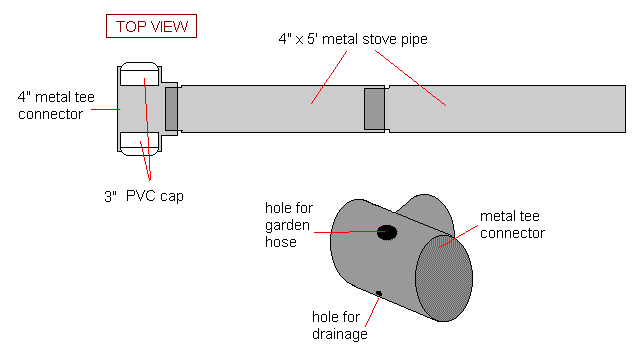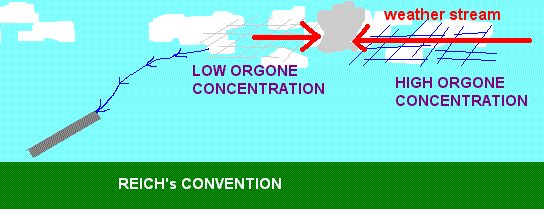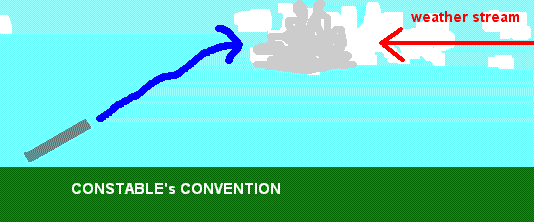Orgonomy and Cloudbusting Demonstration
montalk 8/6/02

This report details the cloudbusting experiment conducted on Monday, July 29th, 2002. In my view, the experiment was a success due to several weather anomalies that apparently resulted. In addition to describing what happened, I will give an overview of orgonomy and procedures for building and operating a cloudbuster. At the end of this report, I will introduce some speculation on the nature of orgone energy and how it relates to topics the Cassiopaeans have discussed.
What is Orgone?
It is a type of sexual life-force energy that can be gathered, beamed, absorbed, generated, or redirected by conscious beings or orgone-based devices. Ultimately, it is an archetypal creative energy, meaning that although it has many manifestations from the psychological to physical, the underlying essence of 'negentropy' remains the same between them.
Psychologically, free flowing orgone is said to be conducive to a free-spirited personality, healthy sexuality, vitality, creativity, and dynamism. Environmentally, ecosystems blessed with strong orgone energies are dense and lively. Physically, strong orgone is associated with negative ions, negentropic (self-organizing) systems, low pressure weather systems, water vapor concentrations, and a blue ionic glow.
An important property of orgone is its strong affinity for water; water can absorb or generate orgone. Another paramount characteristic is orgone's tendency to flow from low concentrations to high concentrations.
Motionless water acts as a sponge or capacitor for orgone energy. It absorbs all lower concentrations of orgone from objects or beings near it. Should water come close to an object with higher orgone concentrations, it will dump its energy into that object.
Motion or turbulence in water infuses it with orgone energy. This is probably due to turbulence creating nonlinear conditions in water; nonlinearity fertilizes a substance for the reception of consciousness-associated energies.
Another method for generating orgone is through orgone accumulators. These are boxes, blankets, or pillows made with alternating layers of organic and inorganic substances, such as steel wool and cotton. Such a configuration strongly generates or absorbs orgone, but has a problem of easily depleting or saturating itself. When an orgone accumulator is saturated or depleted, it no longer functions as effectively until discharged or recharged, usually by placing it near water or placing it in fresh air and sunshine.
Orgone energy is not easily blocked by haphazard walls of metal, glass, or plastic. Only geometric configurations have the ability to channel or redirect orgone energy. Cones, pyramids, and cylinders are shapes that interact well with orgone. Cones, especially truncated cones made of sheet metal, tend to channel orgone from the base to the truncated apex. Cylinders, such as metal pipes, channel orgone in a linear direction, much like waveguides. Nevertheless, metal tends to reflect orgone, and non-metal tends to absorb it.
Cloudbusters are devices that alter orgone concentrations in the atmosphere. Because strong orgone is associated with dense water vapor concentrations, altering orgone levels changes the distribution of condensed water vapor, i.e. clouds. Orgone is proto-meteorological, meaning it precedes (in the chain of cause and effect) visible weather.
Background
In 1995, I began researching orgone energy and performed over a hundred weather modification trials during the next several years. The consistent results of these experiments were very convincing; so-called "cloudbusters" do function as claimed, altering weather patterns, creating weather systems, and stopping or inducing rain depending on the method used.
Weather is naturally chaotic, so it was difficult back then to discern whether meteorological changes were due to the influence of a cloudbuster, or if they would have happened anyway without the presence of such a device. To determine which was the case, I conducted numerous trials, comparing the weather during weeks of cloudbusting to those of non-cloudbusting. The greater and more consistent the differences between those weeks, the stronger the correlation between cloudbusting activity and its predicted effects.
I consider anomalous weather to be anything seemingly beyond chance -- my experiments regularly produced anomalous weather phenomena such as hailstorms on calm days, strong rain when none was forecast, strange bends in the jet stream ("omega blocks" or "cut-offs"), and various odd cloud shapes such as funnels or waves. When the cloudbuster was not being used, normal weather was prevalent. I could design cloudbusting experiments to induce desired alterations of the weather, and the repeated match between predicted outcome and actual outcome suggested that this technology was valid.
Introduction
Normally, I try to stay away from inducing severe weather because it is dangerous and contrary to the "Cloudbuster Operator Code of Ethics" which emphasizes that cloudbusters are not to be used for fun or show, but for correcting weather imbalances such as droughts or torrential weather. When Laura asked me to help build and demonstrate a cloudbuster for the Cassiopaea group attending the conference, I agreed because it was to be an educational experience which justified any associated risk.
My goal was to build a cheap but effective cloudbuster that would demonstrate three effects: the dissolution of clouds, building of clouds into thunderheads, and the damming of clouds. A short sprinkle, I assumed, would be enough to convince healthy skeptics that the cloudbuster might actually work.
I was used to experimenting in Midwest with relatively stable weather patterns, and miscalculated the volatility of Southeast weather. In short, the neighborhood was hit with everything shy of a tornado. We experienced a rare hailstorm, sideways rain, strong winds that ripped off some tree branches, vortical storm movements, and incredibly loud thunder. Definitely overkill, but as far as educational value goes, it was worth every drop of rain. There were mixed reactions of thrills, cheers, panic, amusement and amazement, but many seemed to have viewed this as a positive experience, a demonstration of something involving higher density energies and processes.
Chronological Account of the Experiment
Monday afternoon, we drove to Home Depot to gather parts for a cloudbuster. Even though Laura requested a fully equipped cloudbuster with all the bells and whistles, I was uncertain whether the experiment would work and decided to build the cheapest that would get the job done. This would save money if the experiment ended inconclusively. The simplest cloudbuster consists of a metal pipe with one end contacting running water. A fancy cloudbuster uses multiple barrels, is mounted on an adjustable tripod, and employs a water atomizer nozzle to spray mist into a chambered end where the pipes are inserted.
For this experiment, I chose to use a single ten foot pipe: one end open, and the other a chamber into which water from a garden hose would be sprayed. At Home Depot, we found two five foot long stove pipes which we later connected end to end. To create the chamber, we used a metal tee connector and capped off the two side openings with PVC endcaps. A metal backplate could have sufficed instead of the tee, but none was available at the time. The tee connector and PVC endcaps formed a chamber into which two small holes were cut, one into the top for a garden hose, and one into bottom for drainage.

We constructed the device in the back yard, using duct tape to secure the PVC endcaps, and screws to hold the two pipes together. Then we picked a location in the center of the yard with a good view of the sky and propped up the device on a lawn chair. A bag of fertilizer was set over the lower chambered end to keep the device from tipping over.

As soon as the rest of our group arrived, the experiment began. With the pipe pointed 45 degrees upward into a clear section of the sky, I turned on the garden hose halfway to create a strong spray into the pipe's end chamber.
The first demonstration involved building up a small cloud into a larger one. There was a puffy cumulous cloud above the treeline, surrounded by blue sky to its upper right. I aimed the cloudbuster into that section of blue sky and waited. All clouds were moving over us, against the direction of aim.
According to Reich's theory, orgone flows from low concentrations to high concentrations. The cloudbuster's purpose is to decrease orgone concentrations/potentials in the aimed regions of sky, mainly by "drawing" in orgone from that region and channeling it into the chambered end, to be absorbed and flushed away by the running water. By pointing at the blue sky surrounding a cloud, orgone potential is lowered there, causing the remaining orgone to flow into the cloud, the nearest higher-potential area.

The targeted cumulous cloud rapidly grew in size. One could see the top part mushrooming upward, more quickly than normal. As the cloud grew in size and moved toward us, the right half was visibly sheared off in a straight line originating at the cloudbuster's point of aim. In other words, the cloudbuster was dissolving all clouds in its aimed path, and building up those around the path. Despite partly cloudy conditions, over the next 45 minutes that aimed region of sky remained blue...all clouds entering the region dissolved quickly, leaving behind a cleanly cut channel of blue sky. Meanwhile, the original target cloud continued to grow, turning into a large thunderhead.

By that point, I was convinced the cloudbuster really worked, because the target cloud grew so quickly, its right side was cut off in a long straight edge, and the cloudbuster's point of aim remained free of clouds for over half an hour. These three items of observation were, in my opinion, beyond natural occurrence.
Halfway into the process, an interesting cloud feature developed. It was a funnel-shaped "wave" bowing outward, ahead of the target cloud.

It soon twisted itself into a loop-shape and broke up within minutes.

I'm not sure exactly what this was, but it appeared to be vortical, like a soliton. A soliton is a self-circulating stable wave, like a smoke ring. Just as rapid fluid motion can create turbulence, so might the dynamic orgone streams have created turbulence in the sky. An orgone soliton might account for the observed funnel. In my experience, undulating wave patterns in clouds commonly accompany cloudbusting operations, but this one I had never seen before. That I've never seen them in regular weather either suggests it was an artifact of this particular cloudbusting session.
Besides the building of thunderheads and dissolution of clouds, a cloudbuster is also capable of damming clouds. To do this, one simply aims the cloudbuster directly into the stream of weather. In this case, the weather was moving toward us from the southeast, and so I left the cloudbuster pointing southeast. The original target cloud, which by then was still building and spreading overhead, was southeast anyway, so I did not need to reorient the cloudbuster to do the damming demonstration.
There are two ways to understand how a cloudbuster backs up a stream of clouds.

The first way involves Reich's traditional view, that a cloudbuster draws in orgone energy. Because orgone flows from low potential to high potential, by aiming into the stream of weather, orgone in that region will reverse course and flow upstream to areas where orgone potential remains high. Thus, incoming orgone with high potential is met with returning orgone of lower potential, and a damming effect occurs. In this experiment, by aiming southeast and upward at 45 degrees, orgone in that region had to flow into areas of higher potential, including areas further southeast and lower on the horizon; this was the direction weather was coming from.

The second way involves Trevor James Constable's view that cloudbusters actually beam orgone energy instead of drawing it in. By aiming into the direction of weather, the emitted orgone energy pushes back the incoming clouds and dams them up. Either view demands exactly the same orientation of a cloudbuster and produces the same effects, the damming of clouds.
Forty five minutes into our experiment, the southeastern part of the sky was already looming with darkness and rolling with thunder. Up to that point, the cloudbuster had done a great job of damming up the weather and keeping the aimed region of sky free of clouds. However, after that point, the orgone potential had grown so high that it overpowered the cloudbuster and blue sky quickly disappeared. That was my cue to turn off and remove the device, for it had done all it could do. The fuse had been lit.
With the cloudbuster removed, weather was free to flow overhead like water from a broken dam. Storm clouds rushed toward us with surmounting thunder and accelerating wind. One hour after the beginning of the experiment, we were hit with hail, gusting winds up to 50 miles per hour, and intense sideways rain -- everything short of a tornado.
It continued raining at a moderate rate for several more minutes, and within another hour the rain stopped. The sky that night was clear.
There was a tornado watch already in effect by the time I set up the cloudbuster. Additionally, storms were on the way since 3PM, even though I started the experiment at 5PM. Does this prove that it was all natural weather? I don't believe so. The cloudbuster clearly amplified already approaching storms, damming them up and increasing their severity. Here are several reasons I think what we experienced at Laura's house was unusual:
- this was the first hailstorm in this town in almost eight years
- damage from the storm, like fallen branches, was most intense around the house
- soliton cloud formation halfway into experiment
- on the radar, storms going east/west changed course and converged north or south toward our
- for 45 minutes, aimed section of sky remained blue
- right side of targeted cloud was sheared off in a straight line
- timing between cloudbuster experiment and severe storm was highly 'coincidental'
This graph tracked the temperature, wind speed, and barometric pressure in New Port Richey on July 29th, 2002. Notice the surge in windspeed between 5PM and 6PM, and how the pressure graph is missing a section during that time. Weird.

--- How to Construct a Water-Powered Cloudbuster ----
All you need is a pipe and running water.
Pipe:number - more pipes, broader spread of aim and more powerful the cloudbuster. Multiple pipes aren't really necessary, unless you have small diameter pipes, each with laserpoint areas of coverage. In that case, multiple pipes allow you to cover a broader area. Thus, the smaller the pipe diameter, the better it is to use multiple pipes.
length - longer the pipe, greater the range. A length of five feet is good for local (visible sky) targeting, ten feet is good for areas beyond the horizon. It also depends on pipe diameter. A long skinny pipe is great for long range, while a shorter fat pipe is ideal for very local cloudbusting.
material - cost and durability are all that matter, as long as it's metal. Copper pipes: durable, heavy, but expensive, best suited for fast running water like streams or gushing water hoses. Stove pipes: light, cheap, dents easily, but are good for larger diameters. Best used for finely sprayed water.
diameter - larger the diameter, more local the effect. Copper pipes should have smaller diameters, like 2" or less to keep cost down. Stove pipes should have larger diameters, like 4" to 8".
Examples:
six copper pipes, 10' by 1.5", mounted in two rows of three - traditional, long range and broad coverage
three copper pipes, 10' by 2", single row horizontal - traditional, long range, not as broad
two stove pipes, 5' by 4", single row horizontal - local effects like direct cloud-busting or building
one stove pipe, 10' by 8" - powerful, good range, both local and over the horizon.
one copper pipe, 10' by 2" - long range, will get the job done
Water:
speed - greater the speed, quicker the orgone absorbed/generated
nozzle - finer the spray, more efficient the cloudbuster. By "efficient," I mean both that the cloudbuster works better, and also that less quantity of water needs to be used to get the same effect. Compared to normal running water, finely sprayed water would be more "porous" to orgone and therefore more "absorbent." Additionally, any ionic effects related to orgone would be enhanced since water droplets tend to carry electrical charge. A water hose with a nozzle turned to a fine misted spray works well, but one can also use a portable misting device, also known as "Misty Mates" or "Twist 'n Mist".
type - any water will do, as long as it's moving. Water can absorb/generate only a finite amount of orgone energy, so the purpose of running water is to keep a fresh supply circulating.
Examples:
end sunk into stream or river - unlimited orgone capacity, but cumbersome, low orgone absorption/generation rate
end sunk into overflowing bucket of water - high orgone capacity, but low to medium absorption/generation rate.
gushing water hose in pipe - medium orgone capacity, medium to high absorption/generation rate
spraying water hose in pipe - medium orgone capacity, high absorption/generation rate, most powerful of all
fine mist in pipe or pipe's end chamber - low orgone capacity, high absorption/generation rate, most efficient
*orgone capacity: how much orgone this method can absorb or generate. Higher is better.
*absorption/generation rate: how quickly this method can absorb or generate orgone. Higher is better.
End chambers: optional, otherwise just put end of hose a foot into lower end of pipe.
material:
plastic: cheap, keeps pipes electrically separate, durable, best used for fine mist spraying
metal: complicated, but is electrically united with pipes, so any running water touching the chamber will act as though it were touching the pipes themselves.
Examples:
oval plastic waste basket - encloses end of two pipes, best used for fine mist
plastic bucket with lid - multiple pipes, also for fine mist
metal box - for any number of pipes, electrically united with pipes
back plate on pipe - simplest, best for spray or fine mist
capped tee connector - what was used in experiment, good for spray
--- How to Use a Water-Powered Cloudbuster ----
Altering Local Weather:
Building Clouds: aim cloudbuster at the blue sky surrounding a cloud. This will lower the orgone potential there and cause it to flow into the nearest cloud, building it up.
Busting Clouds: aim cloudbuster at the center of a cloud. According to the traditional convention where cloudbusters draw in orgone, this will draw in orgone from the cloud and into the pipe, making it shrink. According to the newer convention where cloudbusters shoot orgone, aiming it at a cloud will blow it apart like a laser blast.
Damming Clouds: find the direction from which clouds are coming, and aim into it. This will back up the stream of weather, often leading to storms when the dam bursts.
Altering National Weather: this involves the creation of low and high pressure areas. Low pressure systems rotate counter clockwise, and high pressure systems rotate clockwise. This is important when you wish to channel moisture into your target region. Think of high or low pressure systems as giant waterwheels that scoop up moisture over seas and oceans, and dump them onto land.
Wherever you aim a cloudbuster, a high pressure center forms in two to three days. This is because high pressure means low orgone, and by drawing in orgone from a region of the sky, high pressure is bound to result. High and low pressure areas arise in opposite pairs, so a low pressure area will arise opposite the region you aim.
Creating warm fronts: Aim east, or down the jet stream. This creates high pressure east and low pressure west. When the low pressure area moves from west to east as most weather does, it will displace the high pressure area, resulting in a warm front. Warm fronts involve long and steady showers. Aiming down the jet stream also dams up the weather on a large scale.
Creating cold fronts: Aim west, or into the jet stream. Cold fronts involve short but intense storms.
Channeling rain into your area: Pick a large body of water, such as the Gulf of Mexico. Figure out where you need to create a clockwise high pressure system, or counter clockwise low pressure system, to scoop up and carry moisture from that body of water to your target location. Then point your cloudbuster in the direction of the needed high pressure area, or opposite the needed low pressure area.
When doing long range operations like these, the effects you get vary with geographic location. The more humid and tropical the climate, the faster the response. The average response involves a short front-less shower within 24-36 hours, and a warm or cold front in 72 hours.
Duration of session: anything between 30 and 45 minutes is good. Never do it longer than an hour, even if it's your first time and you're looking for definite results. If over the next two or three days you get nothing, despite "drawing" for an hour, then your device isn't functioning properly or the weather simply isn't responding.
height of aim: the higher the aim, the more local the effect. Aiming straight up (90 degrees) is a good way of clearing the sky above of clouds, for dispersing fog, and clearing the weather of light drizzle. Anything below 30 degrees is used for long range cloudbusting.
Repositioning of cloudbuster: when a cloudbuster remains still for more than 5 or 10 minutes, the passing orgone streams (part of the weather) begin ignoring it, much like a stream ignores a rock thrown into it after the ripples fade. Thus, it is necessary to move the cloudbuster slightly every 5 minutes so as to re-shock the orgone streams into responding to it.
Touching a cloudbuster: do not hold onto a cloudbuster for more than several seconds. It will disturb the balance of orgone within you and can lead to either energy drain or over-energizing and fidgeting. Also, if you are attempting to destroy a storm cloud, a cloudbuster will draw in 'deadly orgone' or DOR, which is not good for health -- so if you hold on to a cloudbuster while it is drawing in DOR, you will receive some of it and not feel too good. If you do get affected, symptoms will pass within a day.
When engineering large weather systems (or just cloudbusting in general), there will often be signs on national weather
maps that something artificial is being produced. A weather map two days after a cloudbusting session will usually include occluded fronts (purple dashed lines, meaning stationary weather fronts due to damming effect), and fronts intersecting each other at
harsh angles. Normal weather maps include gently sloping fronts.
Compare this normal map:


------ Discussion -------
Cloudbusters and UFOs
Reich believed alien ships ran on orgone energy, and that by aiming a cloudbuster toward them, their orgone could be drained and the ships made to disappear. To those with the ability to see, orgone energy is blue in color. Some UFO's also emit a blue glow, and this is one reason Reich made such a claim. Reich saw these UFO's as hostile because they fed upon living beings to refuel, and therefore seemed parasitic in nature.
Trevor James Constable also experimented with orgone and UFO's and found that they showed up occasionally during his early cloudbusting experiments. They could be made to leave when the cloudbuster was pointed at them. Most of Constable's observed UFOs could only be captured on infrared film; in those cases, he merely confirmed that they were attracted to his experiments.
In my view, orgone is one type of energy required for 4th density STS beings and crafts to maintain their presence in 3rd density. By draining such a craft or being of orgone energy, they fade out and return to 4th density. The Cassiopaeans said that sometimes, storms in 3D are the result of battles occurring in 4th density. When one creates a storm with a cloudbuster, one is not creating a battle in 4D, but rather generating the same types of energy that are manifested during 4D battles.
Orgone and Loosh
There are different grades to nonphysical energies. Loosh, or emotional/spiritual energy, seems to be of a higher grade than orgone, which is coarser and more etheric. In the case of organic portals, for example, our energies can be drained by just being physically around them, even though our emotional buttons are not triggered -- such energy drains make us physically fatigued. When they do push our buttons, we may feel physically fine but emotionally fatigued and drained of willpower. This shows that OPs can sometimes take one type of energy but not another, and so a difference in those energies must exist. Because orgone can be generated with something as simple as running water, or alternating layers of organic and inorganic materials, I'd guess that orgone is not as sophisticated or refined as emotional energies.
Orgone and the Paranormal
I am certain that orgone or related energies are capable of interfering with nonphysical or variably physical entities. This includes not only 4th density entities here temporarily, but also free-roaming etheric/astral entities. Robert Bruce claims in his latest book "Practical Psychic Self Defense" that negative discarnate entities, when not strongly attached to living humans, have trouble crossing running water. This is because their attempts to do so severely drain them of what energy they need to interact with this reality. Running water, then, appears to absorb such energies, much as it absorbs orgone in a cloudbuster.
Laura has noticed that many apparitions, the type involving repetitive replays of past events, happen in places located above underground streams. It seems to me that running water provides the energy for holographic imprints upon the environment to be energized and played. Even though water has memory, these imprints could be stored in the rocks through which such water flows, rather than in the water itself -- mainly because fresh water is continually passing through the stream, but the rocks remain in place.
Why does running water sometimes absorb energies, and at other times generate it? Probably because orgone flows from low potential to high potential. When an affected object or being has lower potential than the water, it is drained of energy. When the object or being is higher in potential, it absorbs orgone from the water.
In the case of apparitions, the energy of the underground stream might be dormant until something energizes the environment above equilibrium. The underground stream is then triggered into dumping its energy into the region of higher energy concentration, activating the hologram through the rocks and minerals containing that holographic imprint. Additionally, as Laura suggested, certain cosmic factors may be involved related to the alignment of energies, not just their concentrations. This would explain why such apparitions would regularly appear only on certain dates of the year.
During the conference, there was talk of carved stone formations whose grooves might have been designed to channel water. It is possible that ritual acts involving such stones had the effect of raising surrounding energy concentration above that of the water, causing the water to dump its energy and greatly magnify the already present energy. Such high concentrations of energy might result in strange effects, especially when projected through the stones themselves. That orgone flows from low potential to high potential explains why rocks and water alone were not sufficient, but required external raising of energy to switch the mode of water from orgone absorption to generation, thus catalyzing the consciously projected energy of those involved in the ritual.
--- Conclusion ----
Orgonomy requires further research. Its broad scope encompasses many topics discussed in the Cassiopaean group and by the C's, often showing links where none were seen before.
Ultimately, I hope orgone can be studied and quantified to the point of creating reliable devices utilizing orgone's unique properties.
For example, cloudbusters are known to operate best in the hands of positive individuals, so it's conceivable that an orgone-based detector can be built to determine the 'positivity' of a person. By 'positivity', I mean less "mechanical" or "armored", to use Reich's terminology, or less programmed and STS-inclined, to use ours.
The defensive/offensive potential of orgone technology is worth investigating as well. Orgone seems to have hyperdimensional qualities, meaning its effects carry over into nonphysical realms. Through orgone technology, it might be possible to create an unpleasant environment for hostile etheric, astral, and 4th density beings attempting to directly interfere with us or manifest themselves in this physical reality.
Orgonomy provides another piece to the puzzle, another useful paradigmatic platform. It would be wise to discern what orgone really is, and how it relates to all the other subtle energies we know, and finally, how to utilize it for most beneficial purposes.
Microbusting: Altering the visible sky, an introduction to orgonomy and cloudbusting. Written in 1998 by myself.
Macrobusting: Engineering national weather systems, second part to the above link.
Cosmic Orgone Engineering (CORE) - Reich's original cloudbusting manual, very comprehensive but primitive by modern standards. Highly recommended for anyone doing cloudbusting.
Orgone Accumulator Handbook - Dr James DeMeo, an excellent primer on orgone energy and devices. This book tells you how to make orgone accumulators.
Loom of the Future - Trevor James Constable, documented work of Constable's experiences in cloudbusting with waterless devices. This book takes Reich's work to a new level. Lots of pictures of cloudbusters.
Cosmic Pulse of Life - Trevor James Constable, how orgone energy and UFO's are connected.